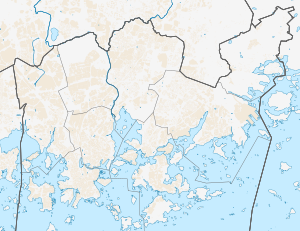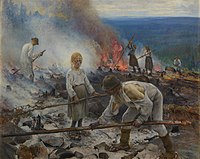Ateneum
- For similarly named entities, see Athenaeum (disambiguation)
 Ateneum building by Theodor Höijer | |
The location of the museum in Helsinki | |
| Established | 1887 |
|---|---|
| Location | |
| Coordinates | 60°10′12″N 024°56′39″E / 60.17000°N 24.94417°E |
| Type | Art museum |
| Key holdings | The Wounded Angel, Lemminkäinen's Mother, Aino triptych, Raatajat rahanalaiset (Kaski), Street in Auvers-sur-Oise |
| Collection size | 4,300+ paintings, 750+ sculptures |
| Visitors | 400 000 (2012)[1] |
| Director | Susanna Pettersson |
| Website | ateneum.fi |
Ateneum is an art museum in Helsinki, Finland and one of the museums of the Finnish National Gallery. It is located in the centre of Helsinki on the south side of Rautatientori square close to Helsinki Central railway station. It has the biggest collections of classical art in Finland. Previously the Ateneum building also housed the Finnish Academy of Fine Arts and University of Art and Design Helsinki. The Ateneum building is owned by Senate Properties (Template:Lang-fi), the government real estate provider.
Collections
The collections of Ateneum include extensively Finnish art all the way from 18th-century rococo portraiture to the experimental art movements of the 20th century. The collections also include some 650 international works of art. One of them is Vincent van Gogh's Street in Auvers-sur-Oise (1890): when the painting was deposited in 1903 Ateneum became the first museum in the world to own a Vincent van Gogh.[2]
Notable works
-
The Road Bridge at L'Estaque, Paul Cézanne, 1879/1882
-
The Fighting Capercaillies, Ferdinand von Wright, 1886
-
Women Outside the Church at Ruokolahti, Albert Edelfelt, 1887
-
Street in Auvers-sur-Oise, Vincent Van Gogh, 1890
-
Aino Myth, Triptych, Akseli Gallen-Kallela, 1891
-
Under the Yoke (Burning the Brushwood), Eero Järnefelt, 1893
-
The Wounded Angel, Hugo Simberg, 1903
-
Portrait of the Artist Léopold Survage, Amedeo Modigliani, 1918
Architecture

The Ateneum building was designed by Theodor Höijer and completed in 1887.
The facade of Ateneum is decorated with statues and reliefs which contain a lot of symbols. Above the main entrance, in the second floor, are busts of three famous classical artists: architect Bramante, painter Raphael and sculptor Phidias. Above the busts, in the third floor, four caryatids support the pediment. These symbolize the four classical art forms: architecture, painting, sculpting, and music. The facade culminates in a collage of sculptures in which the Goddess of Art blesses the products of the different art forms. All the statues were by Carl Sjöstrand. In between the second floor windows are several reliefs by Ville Vallgren representing Finnish and international artists.
Below the pediment's collage is a phrase in Latin: Concordia res parvae crescunt, It is usually understood to refer to the long-lasting battle of the Finnish art circles in order to establish the museum.
See also
References
- ^ "Ateneumin kävijämäärässä kaikkien aikojen ennätys" (in Finnish). Helsingin Sanomat. January 2, 2013. Retrieved February 20, 2014.
- ^ "International collection". Ateneum Art Museum. Retrieved February 20, 2014.









